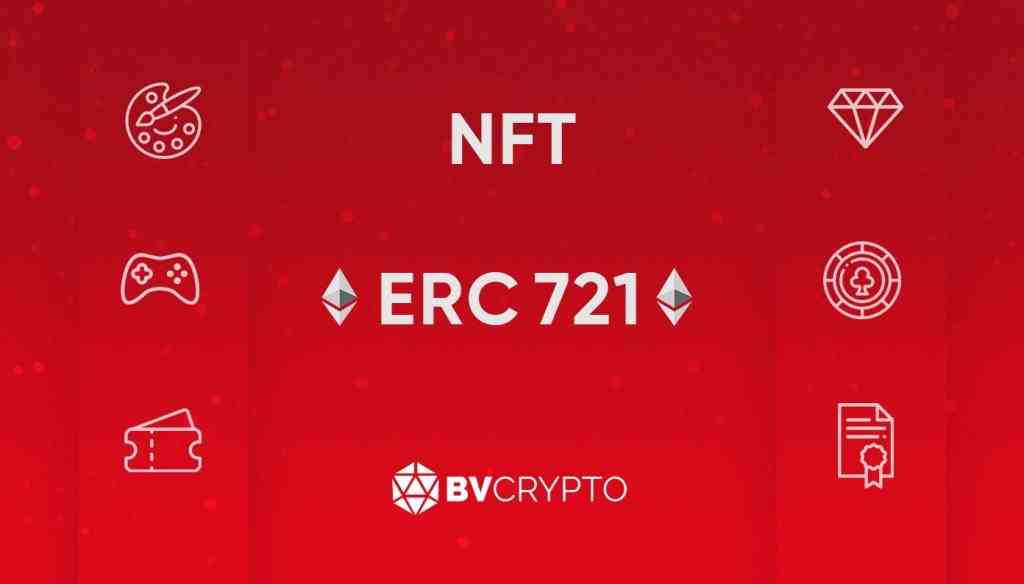
Usages of NFT (Non-Fungible Tokens)
Recently, the artwork Morons by perhaps the world’s most famous anonymous artist, Banksy, was burned on live stream by a blockchain company called Injective Protocol. The act was not committed for a protest or any similar purpose. The burnt artwork was turned into a digital asset as an NFT.(link) Perhaps for the first time, a work of art has lost its physical form, literally being carried into the digital world. So, what does this mean? What is an NFT? In this article, we will give a brief description of NFT and examine its current and potential uses.
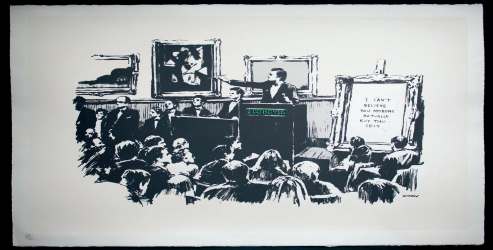
NFT is short for ‘non-fungible token’. As a type of cryptocurrency, NFTs are produced in a limited number and can be transferred from person to person on a blockchain network just like other cryptocurrencies. NFTs have similar properties with other cryptocurrencies however tokens other than NFT can be change (such as their working system, amount, etc.) by the decision of the community or a company. This is where NFTs differ from other cryptocurrencies. NFTs are produced in an amount decided at production and such amount cannot be changed.
This unchanged amount of tokens has made NFTs ideal for use in assets in limited numbers. Works of art are great examples since they are rare and unique. Hence, apart from existing digital art, artworks in physical form like the ‘Morons’ painting can also be turned into digital assets through NFTs.
Considering the example of the Morons, 1 NFT was generated for the painting. This NFT, as mentioned, is a cryptocurrency. The wallet containing this NFT is the owner of the Morons painting. An NFT cannot be counterfeited. Therefore, it is precisely determined without error which wallet the owner of the painting is. Thanks to NFT, the painting cannot be forged or duplicated.
Since NFTs protect the ownership of the original asset, their area of use has spread over a much wider spectrum. NFTs also create their own areas of use. Twitter’s founder and CEO Jack Dorsey put on sale his first tweet on the platform as an NFT.(link) The highest bid for the tweet, $2.5 million, was made by a Turkish person with the username sinaEstavi.
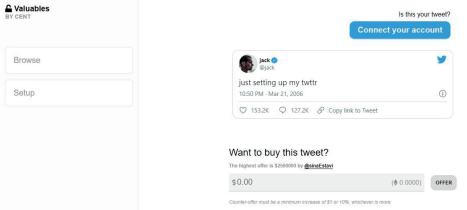
NFTs not only prove the originality of each limited asset, but also reward the creator of the product. Because NFTs require a certain amount to be sent to the creator in each transfer. This amount can be considered like a kind of commission; it is determined by the creator at production and cannot be changed in the future. People who are familiar with football can liken this system with the transfer fees paid to clubs that raise the players.(We will list a number of platforms to show the sectors that are related to the areas of use of NFT. The platforms listed here are only examples to give information about the areas of use of NFT. BV Crypto shall not be held responsible for direct or indirect investment transactions to these platforms.)
Digital Art
Digital art is where NFTs are most commonly used. Since art can be created in any field and subject, all kinds of designs, photography, and other products produced in digital environment are within the scope of digital art. Beside NFTs, the cryptocurrency community is also focused on this area. So, there is a specific diversity in this industry. Digital art NFTs can be purchased for aesthetic reasons or for collecting and value storage purposes. Hence, NFTs are no different from artworks in physical form.
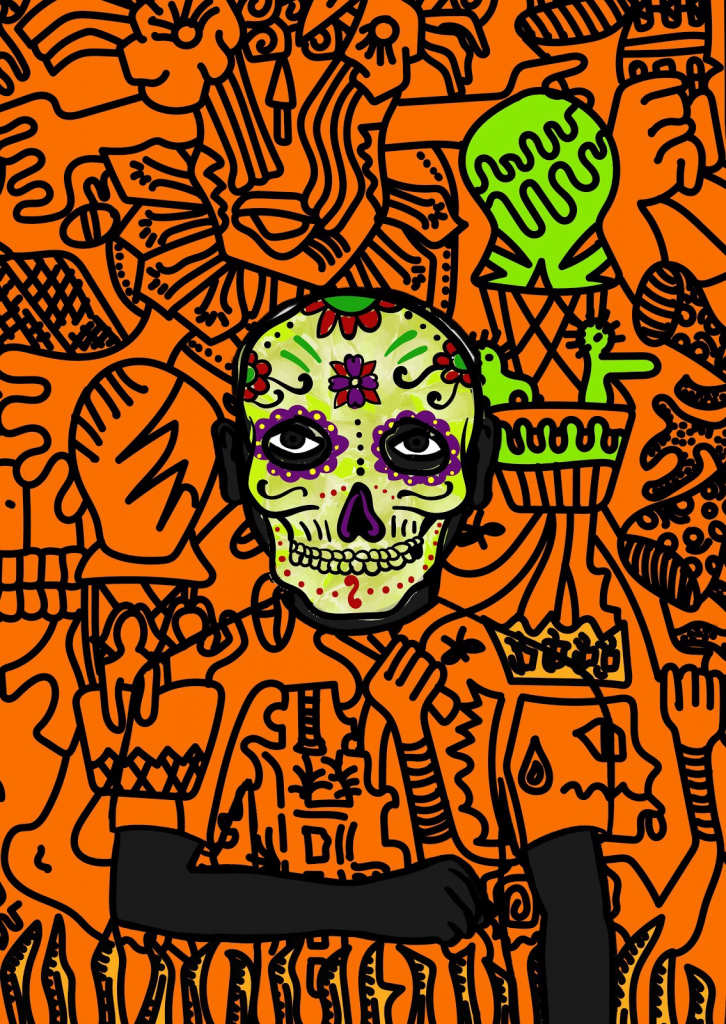
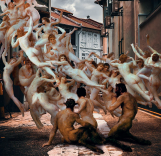
The NFT on the right is a Hashmask, an ideal example for digital art. Extremely popular among NFTs, Hashmasks are among limited edition cult products. Click here to see other Hashmasks. Each Hashmask is defined to one single NFT. This means that there is only 1 of each Hashmask and they cannot be reproduced. Also, unique names are defined for these Hashmasks. Other than Hashmasks, the avatar model on the right is another popular design among digital artworks. The fact that these designs consist of pixels gives them cult features. Click here to see this product and others alike.
Virtual Cities
There are various virtual world platforms like Decentraland and Cryptovoxels that you can access through your browser and they allow you to buy land, decorate your buildings, and organize events, like in real life. The plots, items, and clothes in this virtual world are all in NFT format. For example, 1 NFT is generated for a specific parcel and this parcel is matched with this token. So, the owner of the token is the owner of the land. The users can design their property if they wish. They can buy items like pots, tables, chairs, pools, and boats in NFT format and use them on their own land.
In these virtual worlds, other than those who design their lands, there are also exhibitions and online stores where the aforementioned artworks are exhibited, and places that are turned into theaters, streaming Twitch and YouTube broadcasts. So whatever design or space you want to create on your land is entirely up to you.
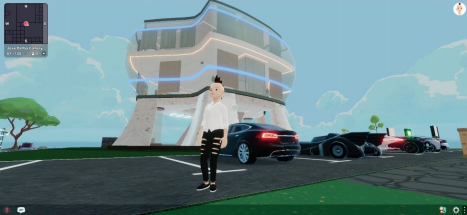
The screenshot above is taken from the virtual city of Decentraland. The building, cars, and the clothes of the avatar in the screenshot can be purchased as NFTs and sold to another user.
A different design can be seen in the screenshot below from Cryptovoxels. The image includes a multi-storey building by the sea. On the left side of the screen, there are cars in a building and seating areas directly opposite.
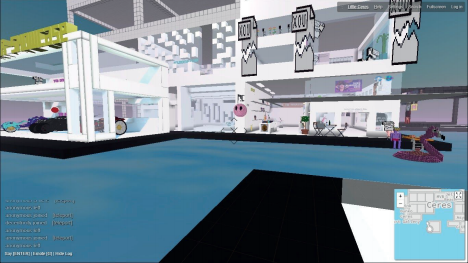
The image below is an example for places where Youtube and Twitch broadcasts are made. This place shows a Youtube video advertising a newly established NFT platform and other exhibits.
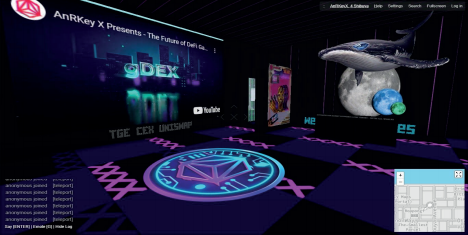
The image below shows examples of virtual world items sold in the NFT market. In the upper left, there is a coat on sale that your avatar can wear in the virtual world and on the right is a land on sale. The other products can also be used for decorations on these platforms.
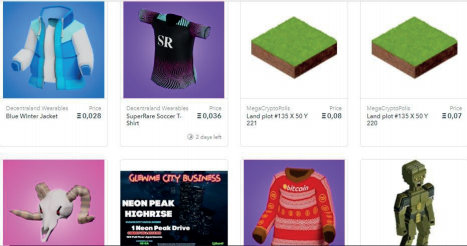
These platforms and other examples that are currently accessible via the browser can reach much more realistic and wider areas of use in the future thanks to VR glasses. With VR glasses and numerous apparatuses, NFTs drive us closer to a life that can be experienced in virtual cities.
Gaming Industry
The card games that many of us played in the past have had a variety of content. The cards are often part of a game involving athletes or anime characters. These types of games have rarely found cards. Collectors are willing to pay large amounts for these, especially for rare cards.
Today, many playing cards are available for sale in the form of NFTs. The best known example of these cards are NBA Top Shot cards. Officially offered for sale by the NBA, these NFT cards represent some epic moves in past games. Someone who owns an NBA Top Shot card, its NFT, becomes the owner of the moment represented on the card. (This can be the moment of a legendary dunk or a pass). The ownership here does not imply copyright. The moment on the card can be viewed for free on Youtube. The cards are solely for collection purposes. (link)
Card collecting is not just limited to the NBA. For example, there is a free platform where games can be played using football player cards produced by the cooperation of Ubisoft and Sorare. As a card game, One Shot League can be played by users who own NFT football player cards. For example, when someone purchases the NFT that represents Cristiano Ronaldo, they can use this card in that week’s lineup. Based on Ronaldo’s real-life performance that week, the user scores points in the game, creates the best team, and wins prizes.
Other than basketball and football, another popular area is F1’s online gaming platform. F1 Delta Time is an F1 racing game. The race cars and race tracks within the game are offered for sale in the form of parcels through NFTs. For example, a person who owns a portion of the Circuit de Monaco regularly earns a certain amount of revenue per in-game race on the tracks. (link)
Another example is the cards of the game called Gods Unchained in NFT form, which can be seen on the image below. Click here to see the image below.
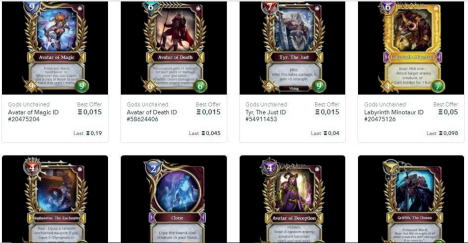
As can be seen above, NFTs offer any rare item for safe and simple use. There is an extremely high possibility that NFTs will be used for ticketed organizations. For example, in events like football games, concerts, exhibitions, etc., people who own NFTs specially organized for the event will gain the right to enter. This way, there can be no fraud. Since NFTs are permanent, these tokens can also be used as souvenirs or for collection purposes after the event.
Luxury Products
NFTs can meet an important need by proving the originality of products and ensuring safe register of their ownership, especially in luxury clothing and accessories. For example, a limited edition luxury clothing or accessory can be matched with a digital asset as NFT. A person who wants to buy this product becomes its real owner as soon as the NFT is transferred to their wallet.
In online sites where these products are sold as second hand, a comparison can be made over the serial number of the product to question its originality. If the product is represented as an NFT, the serial number can be defined on the NFT. Then, it is enough for the buyer to see that the seller has the NFT with the correct serial number. Also, the brand can track the transfer of the product and earn regular income by getting a share after each transfer.
A more concrete prediction is possible through the patent application made by Nike in December 2019. The application mentions transforming shoes into digital assets. The mining and storage of these assets bring NFTs to mind. When Nike offers certain shoes for sale as NFTs, these can be used for collection purposes or can be worn in the virtual worlds mentioned above. Another prediction on the matter is that specially designed shoes are offered for sale as NFTs and when sold, they are specially produced and shipped to the buyer. Indeed, all these ideas are yet hypothetical and are based on Nike’s patent application.
LVMH, which owns a number of luxury brands like Louis Vuitton, Christian Dior, and Don Perignon, cooperates with Microsoft to create its own blockchain platform for originality and product tracking. Considering LVMH’s search for proof of originality, product tracking, and income after each transfer, NFTs fully meet their standards. Thus, we can expect LVMH to use an NFT-like system.
Copyright
As known, copyright refers to the producer or creator and usage rights of a work. We can see the area of use of NFTs for copyrights through the music industry. Currently, many platforms are trying to protect the rights of artists and to create a healthy system of income through NFTs. NFTs have two common types of use for this purpose.
The first is to preview a song or album prior to the release or to make it available to NFT owners only. This way, NFT provides the right to listen to that song or album or to be one of the first people to do so.
The second and perhaps the most important is directly related to copyrights. The copyrights of a music or album can be defined to a certain number of NFTs. For example, someone who owns 40% of these NFTs will gain the right to 40% of the income from the music/album. If an artist wants to use this method, they can earn quick income by selling part of the long-term gains of their music/album. In return, they relinquish some of their future income rights. In the end, the artist may or may not use this method, but the sharing of copyrights and revenues from a music/album can be revolutionary for both the music industry and the internet.
Since copyrights are not limited to the music industry, similar transactions can be made in many other areas like movies and TV series.
Postage Stamps
Postage stamps were chosen as the last of the examples for NFTs due to their different and interesting nature. A post office based in Austria has offered postage stamps in NFT format. Postage stamps with a QR code can be stored in the digital environment as NFTs for souvenir and collection purposes, while physically real. The image below shows examples of postage stamps. The world record for the most expensive postage stamp belongs to this post office thanks to NFT. (link)
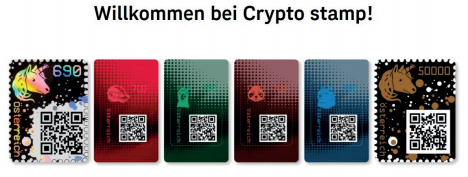
The examples above show that, although still new, NFTs appeal to a wide area and have the potential to reach much more diverse industries in the future. The functionality of cryptocurrencies often takes place within the crypto market. There are only a few cryptocurrencies that can work in integration with a platform outside of the crypto market. However, even so early in its journey, NFT attracts many participants from outside the crypto market. Today, as the use of NFTs becomes widespread, they are criticized since the monetary values they represent have reached serious amounts. However, the value of an NFT comes from the fact that it provides an unquestionable proof for the originality, creator, and ownership of any product. It is also obvious that NFTs have no other functionality and are purchased solely for aesthetic or collection purposes. These high values should be considered normal for NFTs that represent digital art, just like the high prices of paintings by famous painters. Ultimately, the value of a product is determined by the demand for it. This value does not need to be reasonable.
The use of artworks as a financial value storage tool and not for aesthetic purposes can also be done through NFTs. Hence, in the future, we can expect an accelerated transition from physical to digital form, perhaps not by burning as in Morons by Banksy, but through other methods.
Finally, as they grow day by day and penetrate a totally new area, NFTs find buyers only through certain markets. New products and trends can be accessed through these markets. The links below represent 4 of the most popular markets.
Written By: Berkay Aybey
The opinions and comments expressed here belong to BV Crypto. BV Crypto cannot be held responsible for any financial transactions made on the basis of this post. Every investment and trading move involves risk. When making your decision, you should do your own research.
